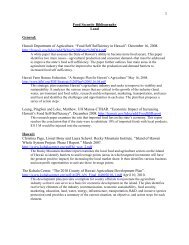Hawai'i Fisheries Initiative - The Hawaii Institute for Public Affairs
Hawai'i Fisheries Initiative - The Hawaii Institute for Public Affairs
Hawai'i Fisheries Initiative - The Hawaii Institute for Public Affairs
You also want an ePaper? Increase the reach of your titles
YUMPU automatically turns print PDFs into web optimized ePapers that Google loves.
Photo courtesy JOHN KANEKO<br />
sell their catch almost exclusively through<br />
wholesalers and corporations that own<br />
their vessels, Hawai‘i’s fish auctions offer a<br />
direct marketing option <strong>for</strong> Hawai‘i’s fishing<br />
fleet. <strong>The</strong> fish auctions in Honolulu (run by<br />
United Fishing Agency) and Hilo (Suisan<br />
Company) are the only systems in the U.S. –<br />
other than Fulton Street Market in New<br />
York and a new auction in Portland, Maine –<br />
where buyers can inspect the product<br />
prior to bidding. 62 United Fishing Agency<br />
can move upwards of 160,000 pounds<br />
of fish a day through the Honolulu fish<br />
auction (typically from 70 to 80 percent of<br />
seafood is landed in the port of Honolulu<br />
and is sold via its auction). 63 <strong>The</strong> auction<br />
process contributes to the high quality of<br />
Hawai‘i’s seafood: At the auctions, highly<br />
experienced buyers inspect the quality of<br />
the catch and bid competitively <strong>for</strong> the<br />
best fish and lots. In addition, the sashimi<br />
market offers its own price incentives <strong>for</strong><br />
the very freshest and best-handled fish. 64<br />
Fish auctions offer fish by the piece or<br />
lot. Tuna caught by longline are displayed<br />
whole (also called “in the round”),<br />
with wedges cut near the tail so buyers<br />
can inspect the flesh. Large tuna caught<br />
by troll or handline have a lengthwise<br />
quarter removed from the whole fish<br />
so that the core flesh can be inspected.<br />
Marlins are halved crosswise to display<br />
their flesh. Tuna and billfish are auctioned<br />
first, followed by smaller species (which<br />
are displayed in the round), including<br />
bottomfish, reef fish, mackerel, mahimahi,<br />
ono, crab, lobster, and shellfish. 65<br />
19







